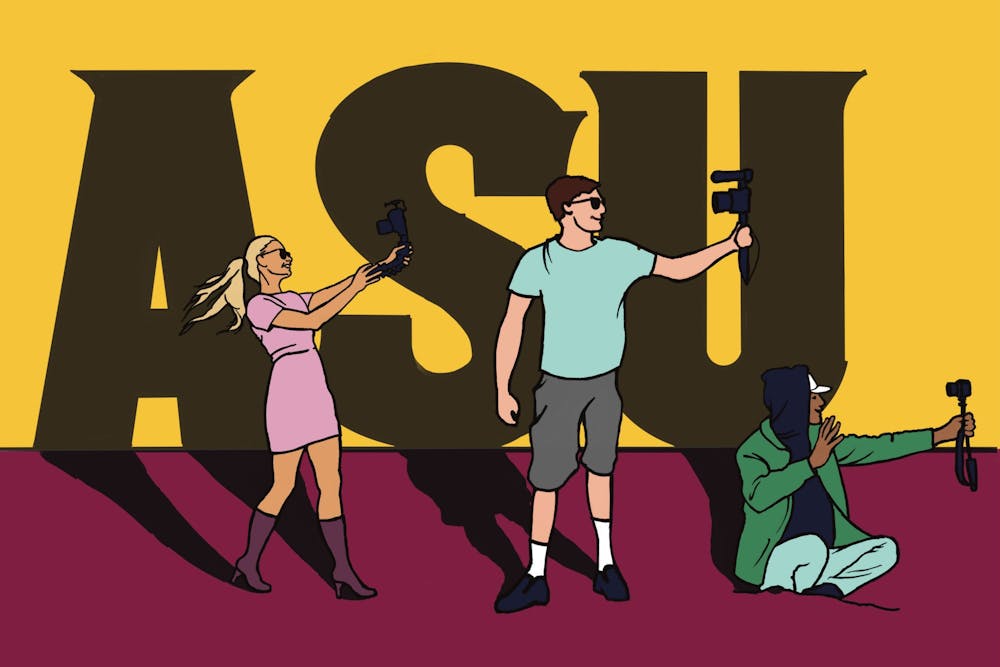Asking questions about students' interests and their current favorite artists are fun ways to interact with students on campus. But the addition of large camera crews and followings puts the pressure on students to answer wisely.
Since the creation of the video streaming app YouTube in 2005, there has been a rise in video content creation. In September of 2016, the viral app TikTok hit app stores worldwide.
Since TikTok's launch, 150 million Americans have downloaded and used the app, making Americans the largest consumers with an average of 95 minutes daily. Over a lifetime, TikTok users can spend as much as 2.3 years on the app.
All that time spent viewing means that demand for content is high – a demand that has reached the ASU campuses.
"There was once this guy who asked for a hug, and his friend was recording. It was an uncomfortable experience, but I just hugged him," said Mia Chavarria, a junior studying graphic design. "I don't know if the video was ever uploaded or if they even used it."
These self-proclaimed "influencers" often create content by interviewing students on their way to class, asking innocent questions about their taste in music or where their outfits are from.
While content creation has been a fun way to interact with students and gain traction, it sometimes leaves students uncomfortable with the finished product. From staged interviews to completely random acts of kindness, the perspectives of students who have interacted with these creators shed light on the worth of these videos.
Influencers look to boost their views by attempting to engage students with more interactive content like scripted responses, pranks and competitions.
Some influencers do so with an entire camera crew in tow.
"Me and my friend are walking into this event, and this random man and about three camera people come up to us and asked us 'who would like to be in a TikTok?'" Reece Johnson, a sophomore studying business communications, said. "We agreed, and he said, 'You guys know that these are all scripted, right?'"
The line the creator gave them was a vulgar reference to his anatomy. After saying the obsenity, the girls were told to walk into a wall. This left them in a situation where they felt embarrassed as fellow bystanders watched.
Even after initially consenting to being filmed, students have no say in how the creator edits the video or in what context the video is uploaded. This can lead to students being represented in a bad light, inviting comments that can have a devastating impact on a student's mental health.
In an effort to preserve these students' privacy, the names of the creators they interacted with have not been included.
"I would say that this video reflected me in bad faith. It's not something that I would want my mother or employer to see," Johnson said. "He made a rap video using the clip of my voice. It made me feel gross and embarrassed."
Some of the content creators have offered financial incentives to participate in their videos.
"He looked at me like he was going to hike a football, but I was listening to my music and did not think much of it," Karli Koskovich, a senior studying sports journalism, said. "I saw a football in the air above my head, so I just looked up and caught it … then, he handed me $500."
Following the interaction, Koskovich witnessed the creator offering the same cash prize to other students, who declined his offer.
"I took the money, looked up and saw the camera guys walking closer and (I) realized I was being filmed," Koskovich said. "And then he turned the camera off and asked me if he could use it for his YouTube video.'"
The act of offering large quantities of cash or gifts is a popular tactic that creators implement. While the creator may have good intentions, still, the video feels forced and unnatural.
"(Content creation) brings a lot of exposure to ASU," said Koskovich. "Some people can do it in a positive manner, and then (there are) people who do it and make it negative, and then based on those videos, it creates ... a chain reaction of what others will think of the school."
Edited by Claire van Doren, Grey Gartin, Sadie Buggle and Grace Copperthite.
Reach the reporter at gmccomes@asu.edu and follow @gmccome1 on X.
Like The State Press on Facebook and follow @statepress on X.

Gillian Mccomeskey is a reporter on the Politics Desk. She has been reporting and producing news articles for 4 years. She has been published by 5 news stations.




